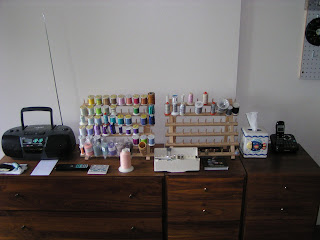 |
| Detail from Seagulls on Parade |
 |
| Seagulls on Parade Based on a Pattern by Linda Worland Created by Gwyned Trefethen |
Why do I seem destined to forget that less is more? Linda Worland designed a relatively simple paper pieced pattern of 5 seagulls on sand with the ocean in the background. It worked out to 4" H x 18 W" as designed. There was no border. I doubled the size of the blocks, multiplied the number of rows by 5, added a 3 strip border and modified the design to cope with a shortage of the water fabric.
 |
| Parallel Lines |
Now I was faced with how to quilt the borders? When I was designing the border I tried out a solid black border as well as a beach themed fabric border. Neither worked. The three strip border worked best for the quilt. However, now that it is time to quilt it the high contrast of value and solid versus pattern was giving me conniptions. Leah must have sensed my dilemma because her very next assignment addressed my question.
 |
| Cartoon Tree |
The assignment for Week 28 was to audition several quilting pattern layouts for a quilt top. In the past I have researched what pattern to use. I have tested my preferred pattern on a practice piece. I have never actually sat down to draft multiple patterns and options to get a sense of how they would look beside each other.
I drew out the piecing diagram of the lower left corner of the border and included a small section of the lower left block. I knew I wanted to use the same quilting pattern in the beach fabric that I had already used - Goldilocks. I also drew in the pattern I used for the blue and green background fabric. The only pattern I was uncertain of was what to choose for the black fabric.
First, I tried the simplest pattern I could think of - parallel lines. My hunch was to set them 1/4" apart. This would certainly make life easy. However, my attempts at stitching in this way often results in the channels looking pushed in opposing directions.
Second, I wanted to see what would happen if the pattern more closely resembled the other pattern in the border and had a similar density. Cartoon Tree fit the bill. It also allowed the beach pattern to run horizontally and the quilting pattern in the black to run vertically. However, it just looks too jumbled to me.
 |
| Scallop Shells with Micro Stippling |
Is less really more? My third and final option was to quilt scallop shell motifs into the black strips and surround them with micro stippling. What was I thinking? This is definitely the most technically difficult option. Thanks to working with Leah for 28 weeks I have the skill set to do it. I also know it will take me several weeks of work. It sure is tempting though.











